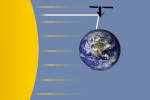
Replica of a first-generation Iridium satellite
Iridium satellite constellation is a network of 66 active satellites in low Earth orbit, that provide L band voice and data information coverage to satellite phones, pagers and integrated transceivers over the entire Earth surface, since 1998. The network is owned by Iridium Communications.
Development[]
Iridium satellite communication was originally conceived by Bary Bertiger, Raymond J. Leopold and Ken Peterson in late 1987 (in 1988 protected by patents Motorola filed in their names) and then developed by Motorola on a fixed-price contract from July 29, 1993, to November 1, 1998, when the system became operational.
First generation satellites were deployed in 1997, developed by Iridium SSC, and financed by Motorola. However, the founding company went into Chapter 11 bankruptcy on August 13, 1999.[1]
The Iridium satellite network continued operation following the bankruptcy of the original Iridium corporation. A new entity emerged to operate the satellites and develop a different product placement and pricing strategy. It offered reliable services in areas of the planet not covered by traditional geosynchronous orbit communication satellite services. Users predominantly included US military units.[2] Full global coverage was complete by 2002.
Pole network[]
The Iridium satellite design has excellent satellite visibility and service coverage especially at the North and South poles. The over-the-pole orbital design produces "seams" where satellites in counter-rotating planes next to one another are traveling in opposite directions.
The Iridium system was designed to be accessed by small handheld phones, the size of a cell phone. This requires a large number of satellites, carefully spaced out in polar orbits to ensure that at least one satellite is continually in view from every point on the Earth's surface. At least 66 satellites are required, in 6 polar orbits containing 11 satellites each, for seamless coverage.
The network of 66 active satellites has six orbital planes spaced 30° apart, with 11 satellites in each plane (not counting spares). Having a set of six planes is sufficient to cover the entire Earth surface at every moment.
Satellite flare[]

Flaring of Iridium satellites due to reflection of the Sun
Because of the shape of the original Iridium satellites' reflective antennas, the first generation satellites focus sunlight on a small area of the Earth surface in an incidental manner. This results in an effect called Iridium flares, where the satellite momentarily appears as one of the brightest objects in the night sky and can be seen even during daylight.[3] The second-gen Iridium-NEXT satellites do not produce flares.
SpaceX[]
In June 2010, Iridium signed the largest commercial rocket-launch deal ever at that time, a $492 million contract with SpaceX to launch 70 Iridium NEXT satellites on seven Falcon 9 rockets from 2015 to 2017 via SpaceX leased launch facility at Vandenberg Air Force Base.[4]
Iridium-NEXT[]
In 2017, Iridium began launching[5][6][7][8] Iridium NEXT, a second-generation worldwide network of telecommunications satellites, consisting of 66 active satellites, with another nine in-orbit spares and six on-ground spares. These satellites incorporate features such as data transmission that were not emphasized in the original design.[9] The constellation provides L band data speeds of up to 128 kbit/s to mobile terminals, up to 1.5 Mbit/s to Iridium Pilot marine terminals, and high-speed Ka band service of up to 8 Mbit/s to fixed/transportable terminals.[10] The next-generation terminals and service became commercially available in 2018.[11]
On January 11, 2019, SpaceX launched an additional ten satellites, bringing the number of upgraded satellites in orbit to 75.[12]
References[]
- ↑ (2005). "Good technology, bad management: A case study of the satellite phone industry". Journal of Information Technology Management XVI (2).
- ↑ New Scientist, Iridium: story of a communications solution no one listened to, by Doug Millard, 3 August 2016
- ↑ Catching a Flaring/Glinting Iridium. Visual Satellite Observer's Homepage. Retrieved on Dec 28, 2011.
- ↑ SPACE.com, Largest Commercial Rocket Launch Deal Ever Signed by SpaceX , 2010-06-16.
- ↑ Peter B. de Selding (29 April 2016). First batch of Iridium Next satellites good to go for July SpaceX launch. Space News.
- ↑ GPS World Staff (17 January 2017). SpaceX launches first batch of Iridium NEXT satellites. GPS World.
- ↑ Jeff Foust (25 June 2017). SpaceX launches second batch of Iridium satellites. Space News.
- ↑ Caleb Henry (9 October 2017). SpaceX launches third set of Iridium Next satellites. Space News.
- ↑ Iridium, What's NEXT?
- ↑ What Is Iridium NEXT?.
- ↑ Thales and Cobham unveil Iridium Certus terminals (in en).
- ↑ Iridium NEXT – NASASpaceFlight.com.